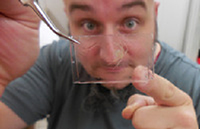 Paula Giovana Pazinato. LMU Munich, Faculty of Biology, Grosshaderner Str. 2, 82152 Planegg-Martinsried, Germany. paula.pazinato@palaeo-evo-devo.info
Paula Giovana Pazinato. LMU Munich, Faculty of Biology, Grosshaderner Str. 2, 82152 Planegg-Martinsried, Germany. paula.pazinato@palaeo-evo-devo.info
Paula G. Pazinato studied Biological Sciences (Bachelor) in Pelotas, southern Brazil, and then moved to São Paulo to study Geosciences and Environmental Sciences, where she got a Master of Science degree with a CNPq scholarship. Since 2018 she is a PhD candidate of the Zoomorphology Group at Ludwig-Maximilians-Universität München, under the supervision of Joachim T. Haug, with a CAPES Scholarship. She develops research in the morphology and evolution of fossil crustaceans, especially Peracarida and, eventually, insects. She is interested in visual communication in science and imaging techniques applied to fossil and extant organisms.
![]()
 Carolin Haug. LMU Munich, Faculty of Biology, Grosshaderner Str. 2, 82152 Planegg-Martinsried, Germany, and LMU Munich, GeoBio-Center, Richard-Wagner-Str. 10, 80333 München, Germany. carolin.haug@palaeo-evo-devo.info
Carolin Haug. LMU Munich, Faculty of Biology, Grosshaderner Str. 2, 82152 Planegg-Martinsried, Germany, and LMU Munich, GeoBio-Center, Richard-Wagner-Str. 10, 80333 München, Germany. carolin.haug@palaeo-evo-devo.info
Carolin Haug studied biology at the Julius-Maximilians-Universität Würzburg with animal ecology as major subject and sociobiology and palaeontology as minor subjects. She received her Diplom in 2005 and moved to the University of Ulm for her Ph.D. thesis. In the work group Biosystematic Documentation she investigated the ontogeny and evolution of the arthropod head shield on a wide spectrum of fossil and extant specimens. Due to the very different demands of the material, she developed new imaging techniques or modified existing methods together with her collaborators, for example, composite imaging, stereo photography or autofluorescence macro- and microscopy. In 2011, Carolin defended her Ph.D. thesis. She was a postdoctoral researcher at Yale University and at the Ernst-Moritz-Arndt-Universität Greifswald. Besides optimising imaging techniques, she is interested in fossilised development (see also http://www.palaeo-evo-devo.info) and in the evolution of tagmosis. For this purpose, she investigates mainly arthropods from different deposits yielding exceptional preservation, such as Rhynie chert, Solnhofen Lithographic Limestones, the 'Orsten', Burgess Shale, or Mazon Creek, always in comparison to their extant relatives. Carolin moved to Munich in 2013 to continue her research there at the Ludwig-Maximilians-Universität.
![]()
 Angelika Leipner. Museum am Schölerberg, Klaus-Strick-Weg 10, 49082 Osnabrück, Germany. leipner@osnabrueck.de
Angelika Leipner. Museum am Schölerberg, Klaus-Strick-Weg 10, 49082 Osnabrück, Germany. leipner@osnabrueck.de
Angelika Leipner is the geological preparator at the Museum am Schoelerberg since 1984. Her research and scientific interest is the upper carboniferous site of the Piesberg quarry in the north of Osnabrueck. She excavates the fossils from there pro bono. At the museum she prepares this fossils and in cooperation with different scientists publishes about fossils of scientific interest.
![]()
 Joachim T. Haug. LMU Munich, Faculty of Biology, Grosshaderner Str. 2, 82152 Planegg-Martinsried, Germany, and LMU Munich, GeoBio-Center, Richard-Wagner-Str. 10, 80333 München, Germany. joachim.haug@palaeo-evo-devo.info
Joachim T. Haug. LMU Munich, Faculty of Biology, Grosshaderner Str. 2, 82152 Planegg-Martinsried, Germany, and LMU Munich, GeoBio-Center, Richard-Wagner-Str. 10, 80333 München, Germany. joachim.haug@palaeo-evo-devo.info
Joachim T. Haug studied animal ecology (major), sociobiology and palaeontology (minors) at the Julius-Maximilians-Universität Würzburg. After the receipt of the Diplom in 2005, he moved to the work group Biosystematic Documentation at the University of Ulm for his PhD thesis. There he worked on the early crustaceans from the Cambrian 'Orsten', which are preserved three-dimensionally and with minute details. To make the entire morphology clearly visible, Joachim produced computer-based 3D models for each developmental stage of a species, resulting in a 4D model of the species. With 4D models reconstructed for the different species, differences in the developmental pattern between the species became visible. These changes in the developmental timing, so-called heterochronic events must have occurred several times during early crustacean evolution. Due to these findings, Joachim got interested in studying such evolutionary changes of development also in fossils from other deposits and focussed on Palaeo-Evo-Devo (see also http://www.palaeo-evo-devo.info). After his defense in 2009 and two further years as postdoctoral researcher in Ulm, he received two Feodor Lynen research fellowships from the Alexander von Humboldt-Foundation, with which he was doing research at Yale University and at the Ernst-Moritz-Arndt-Universität Greifswald. Besides 3D modelling, Joachim is also interested in different methods of imaging (documentation and presentation). In September 2013, he relocated to the Ludwig-Maximilians-Universität in Munich. In April 2018 Joachim became a Lichtenberg professor at the Ludwig-Maximilians-Universität München (LMU Munich) funded by the Volkswagen Foundation.

